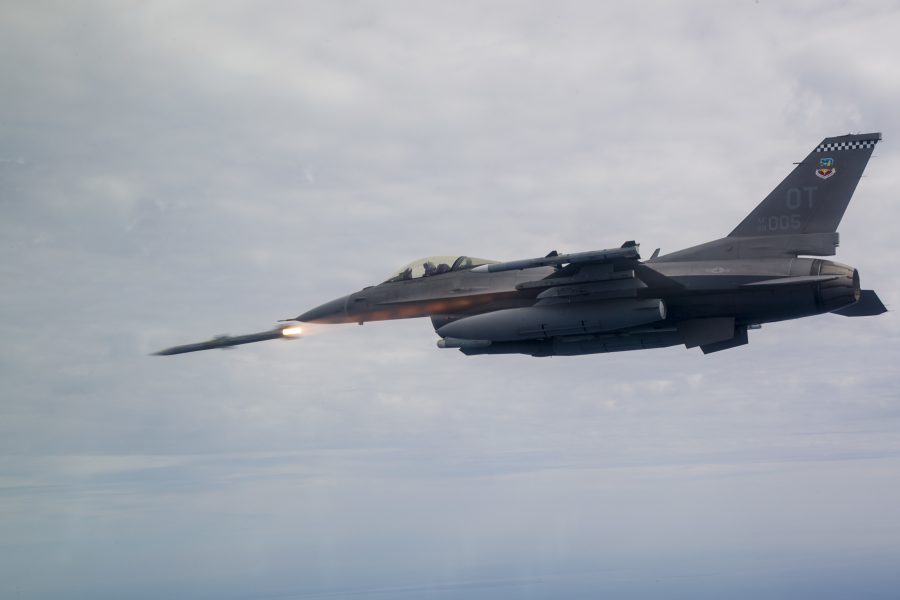In recent military engagements, the Ukrainian armed forces have reported significant successes against Russian aircraft, raising speculation about the potential involvement of F-16 fighter jets or a new NATO weapon to counter the Russian military.
China ‘Dangles’ Aircraft Carrier-Killer Missiles After US Navy Deploys Carl Vinson CSG In South China Sea
On December 5, the Ukrainian military made headlines by announcing the downing of a Russian jet in the vicinity of Snake Island, a Black Sea outpost located approximately 30 miles from Ukraine’s coastline near Romania.
This incident served as a precursor to subsequent clashes between the two forces.
On December 17, Ukrainian media reported the loss of a Russian Su-34 fighter bomber after Kyiv targeted a Russian air base. Simultaneously, Ukraine’s air force claimed that Moscow had shot down one of its own Su-25 tactical bomber jets on the same day.
The conflict escalated further on December 22 when Ukraine claimed the downing of three additional Russian Su-34 bombers. December 24 brought news of further Ukrainian success, as Kyiv alleged the destruction of a Russian Su-30 and another Su-34.
In the early hours of December 26, a Ukrainian missile strike targeted Russia’s Novocherkassk landing ship in Crimea, resulting in significant damage. These successive victories have fueled speculation about the potential involvement of F-16 fighter jets in Ukraine’s military operations.
While Western and Ukrainian officials had earlier indicated that Ukraine would not be receiving F-16s this year, the recent string of successes has prompted renewed discussion about the possibility of these fighter jets being used by Ukraine.

Newsweek, citing sources, recently claimed that there is a strong likelihood that Ukraine has indeed received the initial batch of the promised F-16 fighter jets. Yet, there is currently no tangible proof supporting this assertion.
On December 26, it was reported that the initial cohort of six Ukrainian pilots had finished the foundational training program in the United Kingdom and initiated the practical phase involving F-16 fighter training in Denmark.
An Indian fighter pilot (retired) who did not wish to be quoted told the EurAsian Times — had the F16s been behind the kill (of Su-34), RuAF would have instantly picked it up. Their arrival in Ukraine cannot be ruled out, but their involvement in an aerial skirmish with RuAF is simply far-fetched.
Russia is meanwhile ramping up the production of fighter jets, with a specific focus on the Su-57 fifth-generation aircraft. In 2023, the UAC (United Aircraft Corporation) significantly enhanced its Su-57 production capabilities and modernized the assembly line for the aircraft.
This involved the elimination of bottlenecks not only in the final assembly shop but also throughout the entire production cycle. Central to this initiative were measures to streamline the procurement of high-tech components from supplier factories and implement advancements in aircraft assembly technology.
These concerted actions aimed to optimize efficiency and elevate the overall production process for the Su-57 fighter aircraft during this period.
Crucial Missiles For Ukrainian F-16
Kyiv had fervently sought fighting falcons to challenge Russia’s aerial supremacy and conduct precision strikes on critical targets.
The F-16s come equipped with advanced avionics and radars, providing a significant upgrade compared to Ukraine’s older Soviet-era jets. Moreover, these modern aircraft are designed to deploy NATO-standard weapons.
“Poorest” Air Force With ‘Most Powerful’ Fighters: Troubled IAF Plans To Fly F-15EX, Rafale, F-16, Su-30MK2, F-16 & KF-21
Ukrainian military leaders want to acquire the AGM-158 JASSM (Joint Air-to-Surface Standoff Missile) from the United States. Developed by Lockheed Martin Corporation and adopted by the US Air Force in 2009, this high-precision munition could enhance Ukraine’s strategic capabilities.
The integration of the F-16 with JASSM provides the capability for aircraft to strike heavily fortified targets from distances extending hundreds of kilometers.

JASSMs, recognized for their stealth and air-launched cruise missile capabilities, can be deployed from various aircraft models. Presently, JASSM launch platforms include the F-35, F-15E, F-16, F-18, B-52, B-1, and B-2. There is also a possibility that Ukraine’s existing aircraft fleet could be adapted for their deployment.
The missile can be armed with a 450 kg bunker-penetrating warhead. A significant upgrade in 2014 extended the range of the second-generation JASSM to an impressive 920 km.
The guidance system of these missiles enables precise targeting of heavily protected land installations and delivers devastating blows to ships at sea.
The missile’s design incorporates composite materials featuring carbon fibers, and the entire body of this missile is constructed using carbon fiber, a choice that significantly diminishes radar visibility.
Furthermore, during a portion of its trajectory, the missile operates at exceptionally low altitudes, navigating with a curvature around the terrain.
This combination of carbon-based composites and low-altitude flight contributes to the missile’s enhanced stealth characteristics, making it less detectable by radar systems.
With such capabilities, these missiles could be launched by aircraft operating well behind Ukrainian lines, effectively targeting and destroying critical structures like the Kerch Strait bridge or thwarting any Russian naval activities in the vicinity of Crimea.
The AIM-120D, another missile intended for Ukraine’s upcoming F-16 fighter jets, offers a crucial advantage with its described “beyond-visual-range” capability as an Advanced Medium-Range Air-to-Air Missile (AMRAAM), designed for practical use in various weather conditions.
With active transmit radar guidance, the AIM-120D promises to enable Ukrainian F-16s to engage and neutralize Russian jets or air defenses from secure stand-off ranges.
This capability is poised to bolster Ukraine’s potential to establish air dominance significantly.
If the Ukrainian F-16s can successfully target and eliminate Russian aircraft with precision from extended stand-off distances, it could shift the balance in their favor within the ongoing air supremacy standoff.
In such a strategic scenario, while Moscow might rely on its stealthy Su-57 fighter jet, the F-16s could still pose a formidable threat to other Russian fighter jets, presenting a challenging dynamic in the contested airspace.
- Contact the author at ashishmichel(at)gmail.com
- Follow EurAsian Times on Google News




